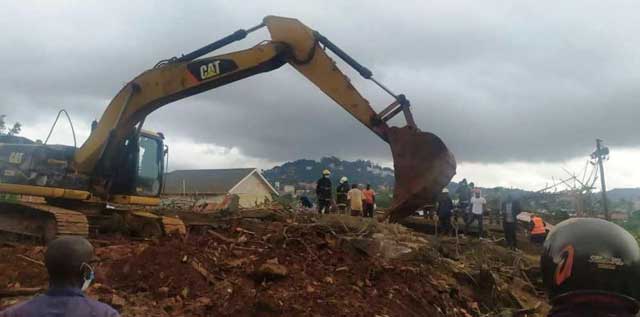
Kampala, Uganda | THE INDEPENDENT | A five floor building that collapsed in Lukuli, Makindye in May last year, killing 13 people was being constructed by an “engineer” by whose highest qualification is a certificate in bricklaying.
This revelation that URN is making public for the first time is in a National Building Review Board -NBRB report of an investigation the board conducted last year following the accident. It is the clearest evidence of unprofessionalism that experts say has been on rise in the construction sector, especially after approval of plans done by professionals, developers run away to hire cheap unqualified builders to take on complex projects.
The developer Abraham Kalanzi and the builder Christopher Ruhambya Bbaandi were arrested by police on 20th May, 2020, ten days after the collapse of the building. They were detained at Kabalagala Police Station. That’s where the team from NBRB that was conducting the investigations found them for interviews on 21st May 2020.
“Mr Ruhambya who appeared before the taskforce with his lawyer Anthony Wameli stated that he completed his Ordinary Level of Education and obtained UCE certificate,” the report says. “Then he enrolled for a certificate in bricklaying at Kasubi Technical School, where he completed in 1978. He said that he started working thereafter, On being asked what he was using to construct, he said that he was using his experience; saying that he had been in the industry for several decades, he could construct without drawings.”
Everything that could possibly go wrong went wrong on that building according to NBRB report: The construction went on at a highly risky speed because it took three months to construct the five floor building, they were using poor quality materials, they have no approved architectural and structural design, they had not done soil investigation, workmanship was poor coupled with poor construction technology.
Both Ruhambya and Kalanzi traded blame on who was responsible for what went wrong. For instance, Ruhambya told NBRB team that he was verbally engaged to carry on the construction and received a drawing (a sketch plan that had no dimensions and 3D drawings) from the Kalanzi to commence the construction work.
But Kalanzi said he advised Ruhambya that they needed architectural drawings and consequently Mr Ruhambya engaged someone to prepare architectural plans. As result, Mr Ruhambya gave Kalanzi a conceptual sketch plan and 3D drawing showing what would be constructed.
According to the report, Ruhambya advised the developer that the next step involved obtaining approvals from KCCA. “The developer gave the builder five million Uganda shillings and a photocopy of the land title to kick-start the process of obtaining approvals from KCCA.,” the report goes on. “He (the builder) informed the developer that KCCA had given them clearance to commence the works as the approval process was ongoing,” the report says.
Both Kalanzi and Ruhambya appeared before Makindye Grade One Magistrate in May 2020 in litigation instituted by families of people who died. In June 2020, the magistrate advised the families that had sued for compensation to settle the case out of court.
A lawyer who was involved in the case told URN in confidence that they compensated the families of people who died. Kalanzi was who pleaded guilty of the criminal charges was also fined 0ne million Shillings only.
And that was end of the case.
Kampala Capital City Authority spokesperson Daniel Nuwabiine corroborated what the lawyer said.
Makindye building
The story of the Makindye building collapse strikingly resembles that of many collapsing building in Kampala. For instance, the NBRB report points to same reasons that led to collapse of Kisenyi building two weeks ago as those of Lukuli, Makindye.
The Kisenyi building was being constructed with poor quality construction materials, mainly concrete and steel, had poor workmanship in the erection of the framework, concrete and general building work, the builder adopted inappropriate construction methods, the building plan had not been approved by KCCA and there was no engagement of professionals before or during construction.
Like the Lukuli, Makindye building, investigations of Kisenyi building stand on a shaky ground. Two weeks after collapse of the building, its owner, Haruna Ssentongo is yet to be interviewed anyone.
“The letter to the alleged developer had not been served as he could not be traced, thus no documentation was obtained for the purpose of this investigation,” the NBRB report says.
Nuwabiine says KCCA had communicated with him through intermediary. “We have not gotten him because the police are still trying to get hold of him. However, we have talked to his agents,” he said.
During recent interviews, Nick Twimatsiko, an author and civil engineering consultant and Dr Apollo Buregyeya, a civil engineering lecturer at Makerere University argued there should more focus on supervision of the construction phase to avert the problem of collapsing buildings.
Who is in charge of construction, what materials are they using, what character the developer is and what role regulators such as KCCA and Uganda National Bureau of Standards -UNBS play in the construction phase, are important questions, they said.
Twinamatsiko said, “Designs in Uganda are always correct but the problem is at the implementation stage where the clients get builders who at most have a diploma in engineering to manage the projects. Some of these builders are awarded diplomas by Uganda Business and Technical Examination Board -UBTEB even after scoring zeroes in exams!”
Twinamatsiko previously served on UBTEB board as a member.
*****
URN
 The Independent Uganda: You get the Truth we Pay the Price
The Independent Uganda: You get the Truth we Pay the Price



